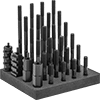Filter by
Thread Size
Fastener Strength Grade/Class
Finish
Thread Spacing
Thread Direction
Hex Nut Profile
Height
Tensile Strength
DFARS Specialty Metals
Export Control Classification Number (ECCN)
Fastening and Joining
Power Transmission
Fluid Handling
Fabricating and Machining
Material Handling
Electrical
Building and Machinery Hardware






























































